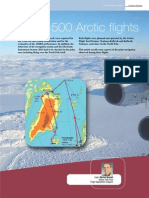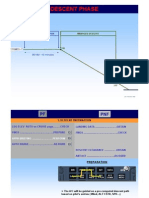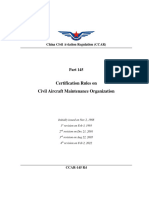100%(1)100% found this document useful (1 vote)
FMS Wind Entry (MD-11)
FMS Wind Entry (MD-11)
Uploaded by
aztec kidThe document discusses how the flight management system (FMS) handles forecast and predicted wind data to support flight plan predictions. It explains that the FMS uses pilot-entered wind data, interpolated values, and default profiles to determine wind estimates along the flight plan. The more comprehensive the wind data provided, the better the FMS predictions will be. It outlines the rules for how values are interpolated and propagated when wind data is incomplete to generate a wind profile for the entire flight plan.
Copyright:
© All Rights Reserved
Available Formats
Download as PDF, TXT or read online from Scribd
Download as pdf or txt
FMS Wind Entry (MD-11)
FMS Wind Entry (MD-11)
Uploaded by
aztec kid100%(1)100% found this document useful (1 vote)
The document discusses how the flight management system (FMS) handles forecast and predicted wind data to support flight plan predictions. It explains that the FMS uses pilot-entered wind data, interpolated values, and default profiles to determine wind estimates along the flight plan. The more comprehensive the wind data provided, the better the FMS predictions will be. It outlines the rules for how values are interpolated and propagated when wind data is incomplete to generate a wind profile for the entire flight plan.
Original Description:
Description of wind entry for MD-11
Copyright
© © All Rights Reserved
Available Formats
PDF, TXT or read online from Scribd
Share this document
Did you find this document useful?
Is this content inappropriate?
The document discusses how the flight management system (FMS) handles forecast and predicted wind data to support flight plan predictions. It explains that the FMS uses pilot-entered wind data, interpolated values, and default profiles to determine wind estimates along the flight plan. The more comprehensive the wind data provided, the better the FMS predictions will be. It outlines the rules for how values are interpolated and propagated when wind data is incomplete to generate a wind profile for the entire flight plan.
Copyright:
© All Rights Reserved
Available Formats
Download as PDF, TXT or read online from Scribd
Download as pdf or txt
100%(1)100% found this document useful (1 vote)
FMS Wind Entry (MD-11)
FMS Wind Entry (MD-11)
Uploaded by
aztec kidThe document discusses how the flight management system (FMS) handles forecast and predicted wind data to support flight plan predictions. It explains that the FMS uses pilot-entered wind data, interpolated values, and default profiles to determine wind estimates along the flight plan. The more comprehensive the wind data provided, the better the FMS predictions will be. It outlines the rules for how values are interpolated and propagated when wind data is incomplete to generate a wind profile for the entire flight plan.
Copyright:
© All Rights Reserved
Available Formats
Download as PDF, TXT or read online from Scribd
Download as pdf or txt
You are on page 1/ 38
1
All rights reserved. No part of this book, CD or pdf
may be reproduced or transmitted in any form or by
any means, electronic or mechanical, including
photocopying, recording, or by any information
storage and retrieval system, without the written
permission of Honeywell International, except where a
contractual arrangement exists between the customer
and Honeywell.
FMS Winds
MD-11 FMS Winds for Flight Plan Predictions
John Lapointe
Flight Technical Services
3 January 2001
3
Objectives
FMS wind basics
Cruise forecast wind entries and defaults
Cruise wind linear interpolation and propagation
Propagation of wind values in cruise
Propagation limitations in cruise
Climb and descent forecast wind entries and
defaults
Climb and descent linear interpolation and
propagation of wind values
Wind blending in cruise, climb and descent
Conclusions
FMS Wind Topics
4
Explain how forecast, current, and predicted
winds are entered, interpolated and propagated
for use in FMS flight plan predictions
Help pilots make better wind related decisions
resulting in improved accuracy of FMS flight plan
predictions and more cost effective operations
FMS Winds - Objectives
5
The FMS wind model supports flight plan predictions
by projecting reasonable estimates of winds along
the flight plan
Wind data is used for ETA's, fuel burn, step climb
points, max/optimum altitudes, flight plan page
altitude predictions, EFOB, descent paths, fix info
page data, econ airspeeds, pred to calculations,
RTAs, path intercept points, et al
Forecast and predicted wind values are based on
pilot entries on the MCDU, uplinked wind data,
and/or default values
FMS Wind Model Basics
6
In-flight, the FMS blends current and forecast
winds to compute the predicted wind
The Message - The more accurate and
comprehensive the wind data provided to the FMS,
the better the quality of its predictions and the
more cost effective your operation can be
FMS Wind Basics
7
Forecast wind for cruise is entered on the VERT
REV 2 page for any cruise waypoint
Linear interpolation of both bearing and magnitude
is used to determine forecast wind between
entered altitudes
Wind values computed for each waypoint can be
reviewed on ACT F-PLN page 2
FMS Winds - Cruise
8
FMS Winds - Cruise
(Example of basic wind matrix and flight plan
with no wind data assigned to waypoints)
FL370
FL330
FL290
A C D E F G H I J B
Flight Plan
Vertical
Profile
Waypoint No Wind Value Assigned Flight Planned Altitude
S/C
S/C
Wind Matrix
9
FMS Winds - Cruise
(Example of fully populated matrix with
data entered at every waypoint)
FL370
FL330
FL290
A C D E F G H I J B
Flight Plan
Vertical
Profile
Waypoint Wind Value Entered Flight Planned Altitude
210/80 210/80 220/70 210/70 290/70 300/60 300/40 010/80 020/80 010/80
230/80 220/70 200/80 290/50 300/60 310/70 020/80 030/70 030/80
200/80
200/80 220/90 310/60 310/80 030/90 020/80 040/90 330/80 220/90 220/80
Best case scenario
10
If no entries of forecast wind exist on the VERT
REV 2 page for any cruise waypoint, forecast wind
for all cruise waypoints will default as follows:
If Trip Wind has been entered, the forecast wind for all
cruise waypoints will be equal to the Trip Wind (Case 1)
See slide 10
Trip Wind is defined as the overall route average wind
and is entered on the F-PLN INIT page
If Trip Wind has not been entered, the forecast wind
for all cruise waypoints will be zero magnitude with
current wind or along track bearing (Case 2) See slide 10
FMS Winds - Cruise Defaults
(What happens when no cruise entries are made)
11
FMS Winds - Cruise Defaults
(Matrix is completed with trip wind default)
FL370
FL330
FL290
A C D E F G H I J B
Flight Plan
Vertical
Profile
Case 1. Trip Wind = HD050 Case 2. Zero (HD000) if no Trip Wind entered
HD050 HD050 HD050 HD050 HD050 HD050 HD050 HD050
HD050 HD050 HD050 HD050
HD050 HD050
HD050 HD050 HD050 HD050 HD050 HD050 HD050 HD050 HD050
HD050 HD050 HD050 HD050 HD050
HD050
HD050
HD000 HD000 HD000 HD000 HD000 HD000 HD000 HD000 HD000 HD000
HD000 HD000 HD000 HD000 HD000 HD000 HD000 HD000 HD000
HD000 HD000 HD000 HD000 HD000 HD000 HD000 HD000 HD000 HD000
1.
2.
1.
2.
12
If there is at least one pilot entry of forecast
wind, then the forecast wind for all waypoints
without entries is determined by propagation
Propagation is defined as copying of entered wind
data from the waypoint(s) where the entry is made
to other waypoints for which no entries have been
made
FMS Wind Propagation - Cruise
(How the FMS deals with an incomplete matrix)
13
Propagation is performed in a forward, horizontal
direction toward the top of descent through each
waypoint until another waypoint is encountered for
which an entry at that altitude has been made
(Rule 1)
If there are no more waypoints with entries at
that altitude, then the propagation is performed
through each remaining waypoint (Rule 2)
For waypoints which are prior to the first
waypoint with a wind entry, propagation is
performed from that first entry in a backward
direction toward the top of climb (Rule 3)
FMS Wind Propagation - Cruise
(Here are the rules - See slide 14)
14
Flight plan modifications which affect any
waypoint with entered forecast winds result in
another propagation of the affected forecast
wind values (Rule 4)
Propagation in a vertical direction is used to
determine forecast winds above the highest and
below the lowest altitude entry (Rule 5)
The forecast wind between successive cruise
waypoints is obtained by linear interpolation of
both bearing and magnitude (Rule 6) This cannot
be seen on ACT F-PLN page 2
Linear interpolation is used to determine forecast
wind between entered altitudes (Rule 7)
FMS Wind Propagation - Cruise
(Here are more rules)
15
FMS Winds - Propagation Rules
(How waypoints get wind values in an incomplete matrix )
FL370
FL330
FL290
210/80 210/80 210/80
A C D E F G H I J B
290/50
Entered Wind Data Propagated Wind
210/80 210/80 210/80 210/80 210/80 210/80 210/80
290/50 290/50 290/50 300/60 300/60 300/60 300/60 300/60
300/60 300/60 300/60 300/60 300/60 290/50 290/50 290/50 290/50 290/50
1,2
6
7
Propagation Rule
3 1* 3
5 5 5 5 5 5 5 5 5 5
3 3 3 3 1* 1* 1* 1*
1* 1* 1* 1* 1* 1*
*Rule 2 also
applies
4 = Flight
Plan Mods
16
When pilot entered forecast wind data is not
assigned to every waypoint, an incomplete matrix
exists and the propagation function assigns
forecast values to all waypoints (Scenario 1) See
slide 17
Scenario 1 demonstrates that propagation of winds
at FL290 assigns a favorable tailwind to the end
of the flight plan
This misrepresentation may cause the FMS not to
generate step climbs at the correct points in the
flight plan as it assumes the higher fuel burn at
FL290 is more than offset by the apparent
tailwind
FMS Wind Propagation
(Managing wind propagation limitations)
17
The inaccurate wind profile will negatively impact
fuel predictions, ETAs, and other performance
functions for the remainder of the flight
Therefore, when an incomplete matrix exists, one
technique is to enter forecast wind data at any
but only one altitude
This will limit horizontal propagation and provide a
more accurate wind profile for flight plan
predictions (Scenario 2) See slide 18
FMS Wind Propagation
(Managing wind propagation limitations )
18
FMS Winds - Propagation
(Scenario 1 - Managing wind propagation limitations -
winds entered at planned altitudes)
FL370
FL330
FL290
210/90 210/80 200/80
200/80 200/80 200/80 200/80 200/80 200/80
220/90
A C D E F G H I J B
290/50 290/50 290/50 290/50
290/50 310/70
310/70 310/70 310/70
030/90 020/80 040/90
030/90 030/90 030/90 030/90 030/90 030/90 030/90
A/C Heading
020
Tail
Cross
Head
Propagated Wind Pilot Entered Wind
300/60
Propagation Direction
19
030/90
FMS Winds - Propagation
(Scenario 2 - Managing wind propagation limitations -
winds entered at any but only one altitude)
FL370
FL330
FL290
210/90 210/80 200/80
290/50 300/60 310/70 030/90 020/80 040/90
A C D E F G H I J B
210/90 220/90 200/80 210/80
310/70
020/80 040/90
030/90 020/80 040/90
210/90 220/90 200/80 210/80
290/50
A/C Heading
020
Tail
Cross Head
300/60 310/70
Propagated Wind Pilot Entered Wind
220/90 300/60 290/50
Propagation Direction
20
The forecast wind for climb is based on pilot
entries on the CLIMB FORECAST page
Linear interpolation of both bearing and magnitude
is used to determine forecast wind between
entered altitudes (Case 1)
Propagation of both bearing and magnitude is used
for forecast wind above the highest entered
altitude (Case 2)
If there are pilot entries on the CLIMB
FORECAST page, but no pilot entry is made for
the origin altitude, the origin altitude forecast
wind will be zero magnitude with a bearing equal
to the lowest entered climb wind bearing
FMS Winds - Climb
(Entered Data - See slide 20)
21
FMS Winds - Climb
(Linear interpolation and propagation
of pilot entered climb forecast data)
Entered Climb
Forecast Data
280/50
FL 250
260/30
FL150
250/20
FL100
240/10
Surface
(FL000)
FL280/280/50
FL210/272/42
FL130/256/26
FL090/249/19
Climb Interpolated
Values
FL000/240/10
2
1
Case 1 = Linear Interpolation Between Altitudes Case 2 = Propagated Value
22
If there are no pilot entries on the CLIMB
FORECAST page, the forecast wind for climb
defaults as follows:
If Trip Wind has been entered, the forecast wind for
climb is ramped linearly from zero at the origin altitude
to the Trip Wind value at 20,000 (Case 1)
If Trip Wind has been entered, the forecast wind for
climb will be equal to the Trip Wind at and above 20,000
If Trip Wind has not been entered, the forecast wind
for climb will be zero magnitude with current wind
bearing (Case 2)
FMS Winds - Climb Defaults
(No data entered - See slide 22)
23
FMS Winds - Climb Forecast
(Trip wind linear interpolation with
no pilot entered climb forecast data)
FL200
T/C
Surface
FL100
FL150
HD050
HD050
HD038
HD025
HD000
Case 1. Trip Wind = HD050 Case 2. Zero if no trip wind entered
HD000
HD000
HD000
HD000
HD000
1
2
24
The forecast wind for descent is based pilot
entries on the DESCENT FORECAST page
Linear interpolation of both bearing and magnitude
is used to determine forecast wind between
entered altitudes (Case 1)
Propagation of both bearing and magnitude is used
for forecast wind above the highest entered
altitude (Case 2)
If pilot entries on the DESCENT FORECAST page
exist, but no pilot entry is made for the
destination altitude, the destination altitude
forecast wind will be zero magnitude with a
bearing equal to the lowest entered descent wind
bearing
FMS Winds - Descent
(Entered Data - See slide 24)
25
FMS Winds - Descent
(Linear interpolation and propagation
with pilot entered descent forecast data)
260/50
FL200
230/10
Surface
(FL000)
240/30
FL100
250/40
FL150
Entered Descent
Forecast Data
FL210/260/50
FL160/252/42
FL120/244/34
FL070/237/24
Descent
Interpolated Data
Case 1 = Linear Interpolation Between Altitudes Case 2 = Propagated Value
1
2
FL000/230/10
26
If there are no pilot entries on the DESCENT
FORECAST page, the forecast wind for descent
defaults as follows:
If Trip Wind has been entered, the forecast wind for
descent is ramped linearly from zero at the destination
altitude to the Trip Wind value at 20,000 (Case 1)
It Trip Wind has been entered, the forecast wind for
descent will be equal to the Trip Wind at and above
20,000 (Case 2)
If Trip Wind has not been entered, the forecast wind
for descent will be zero magnitude with current wind
bearing
FMS Winds - Descent Defaults
(No data entered - See slide 26)
27
FMS Winds - Descent
(Default Trip wind linear interpolation with
no pilot entered descent forecast data)
FL200
T/D
Surface
FL100
FL150
HD000
HD025
HD038
HD050
Case 1. Trip Wind = HD050 Case 2. Zero (HD000) if no Trip Wind entered
1
2
HD000
HD000
HD000
HD000
HD000
HD050
28
The predicted wind for any point is computed by
blending the current wind and the forecast wind
The predicted wind is equal to the current wind at
the current aircraft position and altitude
For cruise, the influence of the current wind
decreases linearly such that the predicted wind
equals forecast wind 200 NM ahead of and 10,000
feet above and below the aircraft (See slides 28-
29)
For climb and descent, the influence of the
current wind decreases linearly such that the
predicted wind equals forecast wind 10,000 feet
above and below the aircraft at any given time
with no forward limit (See slides 30-33)
FMS Wind Blending
29
FMS Wind Blending - Cruise
B C D E
200 NM
Forecast
Airspace
A
Forecast
Current
F
-10000
+10000
Blended
Value
Forecast
Value
40 NM 40 NM 40 NM 40 NM 40 NM
Forecast
Blended Wind
Airspace
Blending
+5000
-5000
30
FMS Wind Blending - Cruise
(Current altitude and off altitude predictions)
B C D E A
Forecast
100%
Current
80%/20%
@B
60%/40%
@C
40%/60%
@D
20%/80%
@E
0%/100%
@F
F
40 NM 40 NM 40 NM 40 NM 40 NM
Forecast
1
2
Example
Wind Value =
1. 40/60 value at current alt then
2. 50% linear between that value and forecast at 10,000 above
100%
Forecast
Blended Value =
% Current and
% Forecast
100 %
Forecast
0%100%
50%/50%
50%/50%
0%/100%
31
FMS Wind Blending - Climb
Blended Wind
Airspace*
10000
Maximum Altitude
Forecast Wind
Airspace
Time Now
T/C
Forecast Portion
of Climb
Blended Portion
of Climb
* Blended airspace has no forward limit
32
FMS Wind Blending - Climb
Forecast
Current
Forecast
+5000
-5000
-10000
+10000
Blending
100 %
Forecast
Blended Value =
% Current and
% Forecast
50%/50%
75%/25%
25%/75%
Time Now
33
FMS Wind Blending - Descent
Blended Wind
Airspace*
10000
Forecast Wind
Airspace
Forecast Portion
of Descent
Blended Portion
of Descent
Time Now
* Blended airspace has no forward limit
34
FMS Wind Blending - Descent
Blending
Forecast
Current
Forecast
+5000
-5000
-10000
+10000
100 %
Forecast
Blended Value =
% Current and
% Forecast
25%/75%
50%/50%
75%/25%
Time Now
35
The better the input of wind data, the more
accurate the FMS predictions
Manual entry of wind data at every cruise
waypoint may not operationally practical so
knowledge of limitations and workarounds can
bring success
As an absolute minimum, trip wind should be
entered on the F-PLN INIT page for every flight
Suitability of using trip wind alone should be
evaluated for each phase of flight
FMS Winds - Conclusions 1/4
36
If even one wind is entered for a phase of flight,
trip wind defaults are overridden and propagation
will determine wind values at waypoints and
altitudes
Propagation may not provide an accurate
representation of the actual wind profile and may
impact the quality of FMS predictions
Accuracy is degraded when winds are propagated
to waypoints that differ significantly from the
forecast at those waypoints
Propagation between a few waypoints where winds
dont change appreciably is insignificant
FMS Winds - Conclusions 2/4
37
Propagation can be limited by entering forecast
cruise winds at any but only one altitude
This technique forces propagation into a vertical
direction except for a small amount of horizontal
propagation between adjacent waypoints where no
entries have been made
If forecast winds are going to be entered, they
should be inputted at waypoints (cruise) or
altitudes (climb or descent) where significant wind
changes occur or there is significant difference
between forecast/current and Trip Winds
FMS Winds - Conclusions 3/4
38
Significant descent forecast winds should be
entered before final descent path computation at
approximately 40NM from the T/D
All vertical profiles will have a blended portion and
a forecast portion and significant variations in
these values can cause problems meeting path
constraints
For all phases of flight, blended airspace is always
referenced from the current aircraft position and
climb and descent have no associated forward limit
Blended or predicted winds are not displayed
The PROGRESS page displays current wind
The ACT F-PLN page 2 displays forecast wind
FMS Winds - Conclusions 4/4
You might also like
- Airbus 320 Family Main FCOM QRH FCTM ChangesNo ratings yetAirbus 320 Family Main FCOM QRH FCTM Changes8 pages
- Boarding Pass: Name Booking Code Ticket NoNo ratings yetBoarding Pass: Name Booking Code Ticket No1 page
- AIRBUS A330 NEW SOP - New Briefing Handout - From - 01 - 04 - 2022100% (1)AIRBUS A330 NEW SOP - New Briefing Handout - From - 01 - 04 - 202218 pages
- A330/A340 Main FCOM/QRH/FCTM Changes September 2018100% (1)A330/A340 Main FCOM/QRH/FCTM Changes September 20184 pages
- Airbus A320 & A319 Study Guide: Aircrew Training Solutions100% (1)Airbus A320 & A319 Study Guide: Aircrew Training Solutions30 pages
- Main FCOM / QRH / FCTM Changes May 2022No ratings yetMain FCOM / QRH / FCTM Changes May 202210 pages
- CAL A330340-FCOM-Performance-CRZ-HLD - 20150630No ratings yetCAL A330340-FCOM-Performance-CRZ-HLD - 2015063080 pages
- Pilot 1-A321 - 1AB Rev01 Date 19jan2022No ratings yetPilot 1-A321 - 1AB Rev01 Date 19jan202218 pages
- Approach Techniques - Aircraft Energy MGTNo ratings yetApproach Techniques - Aircraft Energy MGT11 pages
- NAT Doc 007 Ed V.2024-1 - Eff - 21MAR2024No ratings yetNAT Doc 007 Ed V.2024-1 - Eff - 21MAR2024162 pages
- Differences A320 - A321 - R0 - R - 21may09No ratings yetDifferences A320 - A321 - R0 - R - 21may0923 pages
- Examen Teórico para Obtener o Renovar Habilitación de Tipo Boeing 787 - 800 (B788)No ratings yetExamen Teórico para Obtener o Renovar Habilitación de Tipo Boeing 787 - 800 (B788)75 pages
- SMARTLYNX Pilot Training and Career A5 251021No ratings yetSMARTLYNX Pilot Training and Career A5 2510219 pages
- CAL A330340-FCOM-Performance-DES-GOA-LDG - 20150630No ratings yetCAL A330340-FCOM-Performance-DES-GOA-LDG - 2015063042 pages
- Dual Side Stick Input - Airbus AircraftNo ratings yetDual Side Stick Input - Airbus Aircraft16 pages
- Es5 Statics of Rigid Bodies Chapter4 Lesson1 Part1 Updated OverviewNo ratings yetEs5 Statics of Rigid Bodies Chapter4 Lesson1 Part1 Updated Overview29 pages
- A Simulation of Aircraft Fuel Management SystemNo ratings yetA Simulation of Aircraft Fuel Management System21 pages
- ANSUMAN SHARMA 109ee0305 Department of ELECTRICAL Engineering, NIT Rourkela100% (1)ANSUMAN SHARMA 109ee0305 Department of ELECTRICAL Engineering, NIT Rourkela1 page
- Snubberless Logic Level and Standard 8 A TriacsNo ratings yetSnubberless Logic Level and Standard 8 A Triacs18 pages
- Aircrew Training Manual Attack Helicopter Ah-64d100% (4)Aircrew Training Manual Attack Helicopter Ah-64d410 pages
- Conformal Coating Masking Technical Bulletin PDF100% (1)Conformal Coating Masking Technical Bulletin PDF3 pages
- ICAO-ICAEA RSSTA (1st Edition) Sample InformationNo ratings yetICAO-ICAEA RSSTA (1st Edition) Sample Information7 pages
- Osprey Aircam Aviation Series 23 - Vought F4U1-7 Corsair95% (21)Osprey Aircam Aviation Series 23 - Vought F4U1-7 Corsair52 pages
- Wind Power and Wind Turbines: BY Er - Karthikeyan, Me, Mba, (PH.D)No ratings yetWind Power and Wind Turbines: BY Er - Karthikeyan, Me, Mba, (PH.D)25 pages
- A Study On The Ballistic Damage Tolerance Design of Aircraft StructuresNo ratings yetA Study On The Ballistic Damage Tolerance Design of Aircraft Structures6 pages
- AIRBUS A330 NEW SOP - New Briefing Handout - From - 01 - 04 - 2022AIRBUS A330 NEW SOP - New Briefing Handout - From - 01 - 04 - 2022
- A330/A340 Main FCOM/QRH/FCTM Changes September 2018A330/A340 Main FCOM/QRH/FCTM Changes September 2018
- Airbus A320 & A319 Study Guide: Aircrew Training SolutionsAirbus A320 & A319 Study Guide: Aircrew Training Solutions
- Examen Teórico para Obtener o Renovar Habilitación de Tipo Boeing 787 - 800 (B788)Examen Teórico para Obtener o Renovar Habilitación de Tipo Boeing 787 - 800 (B788)
- CAL A330340-FCOM-Performance-DES-GOA-LDG - 20150630CAL A330340-FCOM-Performance-DES-GOA-LDG - 20150630
- Turbulences: Remeiniscences of of an Airline PilotFrom EverandTurbulences: Remeiniscences of of an Airline Pilot
- Aeronautical Air-Ground Data Link CommunicationsFrom EverandAeronautical Air-Ground Data Link Communications
- Es5 Statics of Rigid Bodies Chapter4 Lesson1 Part1 Updated OverviewEs5 Statics of Rigid Bodies Chapter4 Lesson1 Part1 Updated Overview
- ANSUMAN SHARMA 109ee0305 Department of ELECTRICAL Engineering, NIT RourkelaANSUMAN SHARMA 109ee0305 Department of ELECTRICAL Engineering, NIT Rourkela
- Osprey Aircam Aviation Series 23 - Vought F4U1-7 CorsairOsprey Aircam Aviation Series 23 - Vought F4U1-7 Corsair
- Wind Power and Wind Turbines: BY Er - Karthikeyan, Me, Mba, (PH.D)Wind Power and Wind Turbines: BY Er - Karthikeyan, Me, Mba, (PH.D)
- A Study On The Ballistic Damage Tolerance Design of Aircraft StructuresA Study On The Ballistic Damage Tolerance Design of Aircraft Structures

























































































